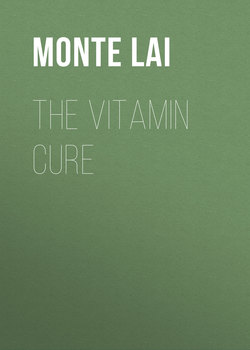Читать книгу The Vitamin Cure - Monte Lai - Страница 13
На сайте Литреса книга снята с продажи.
Оглавление4
VITAMIN B3 (NIACIN)
Vitamin B3 is also known as niacin. Vitamin B3 deficiency can cause pellagra, which comes from the Italian word for “rough skin.” In the late 15th century, Christopher Columbus and his fleets reached South America. Among other things, he brought corn seeds back to Europe. Corn became the main food in Spain, Italy, Egypt, and many other Southern European countries in subsequent centuries. Corn contains niacin, but it is tightly bound to its fibers. Cooking corn in boiled water does not release niacin from the fibers. For thousands of years, American Indians living in South America had developed ways to prepare corn by soaking and cooking it in alkaline lime water. At that time, they had no way of knowing that cooking corn in alkaline lime water released niacin from the corn fibers. Because Columbus brought back corn but not the native Indians’ recipes, the consumption of niacin-poor corn caused vitamin B3 deficiency and thus a pellagra epidemic in southern Europe. Up until the 19th century, many Southern Europeans suffered from pellagra. In 1937, scientists discovered that niacin was effective in treating pellagra and called it “vitamin B3.”
Niacin is involved in the synthesis of NAD and NADP coenzymes. These two coenzymes are essential for enzymatic reactions that convert proteins, lipids, and carbohydrates to energy in the cell. Without NAD and NADP, the body will not be able to produce the energy needed for maintaining the brain, heart, and muscles, as well as other bodily functions.
What Are the Symptoms of Vitamin B3 Deficiency?
• Pellagra. The major symptoms of pellagra are dermatitis, dementia, and diarrhea. Severe diarrhea exacerbates deficiencies in niacin and other nutrients. Pellagra patients with dermatitis generally avoid sun exposure and thus are inclined to stay indoors. Niacin deficiency–induced dementia was often misdiagnosed as psychosis. During the 17th–19th centuries, many pellagra patients in Europe were confined to madhouses. There, these patients continued consuming niacin-poor corn, further aggravating pellagra.
• Tryptophan. Tryptophan can be converted into vitamin B3 in the body. Tryptophan is a common amino acid found in all protein-rich foods. Many animal-based foods and plant-based foods not only are rich in vitamin B3 but also contain tryptophan. Nowadays, instances of vitamin B3 deficiency are rare.
Prevention and Treatment of Diseases
• Prevention. Vitamin B3 may alleviate osteoarthritis.
• Treatment. Vitamin B3 may decrease LDL and triglycerides and increase HDL.
Which Food Items Are Vitamin B3 Rich?
A variety of foods contain vitamin B3, including nuts, brown rice, whole wheat, oats, and legumes. Meat, milk, and fish are also excellent sources of tryptophan. Vitamin B3–fortified foods may include breakfast cereals, bread, rice, and baked goods.
This list of vitamin B3–rich food items is adapted from information provided by the USDA.
| FOOD | PORTION | VITAMIN B3 CONTENT, MG | % DAILY REFERENCE VALUE |
|---|---|---|---|
| Tuna | 3 ounces | 10.0 | 50.0 |
| Turkey | 3 ounces | 10.0 | 50.0 |
| Chicken | 3 ounces | 9.5 | 48.0 |
| Salmon | 3 ounces | 8.5 | 43.0 |
| Beef | 3 ounces | 7.3 | 37.0 |
| Peanuts | 1 ounces | 3.8 | 19.0 |
| Spaghetti | 1 cup | 3.1 | 16.0 |
| Hyacinth beans | 1 cup | 2.1 | 11.0 |
| Bread | 1 slice | 1.3 | 6.5 |
| Coffee | 1 cup | 0.5 | 2.5 |
Daily reference value of vitamin B3 is 20 mg according to the 2013 FDA food-labeling guidelines.
What Are the Recommended Dietary Allowances for Vitamin B3?
| 1–3 years | 6 mg |
| 4–8 years | 8 mg |
| 9–13 years | 12 mg |
| 14–18 years | 16 mg (boys); 14 mg (girls) |
| 19 years and older | 16 mg (men); 14 mg (women) |
The upper daily intake limit of vitamin B3 is 41 mg for men and 35 mg for women.
Vitamin B3 Supplements
• Dosage. The most common dosages of vitamin B3 supplements are 100–500 mg, which well exceeds the daily upper limit of 35–41 mg. Common side effects of vitamin B3 include flushing, fever, and itching.
• Types. Vitamin B3 supplements contain niacin, nicotinic acid, inositol hexanicotinate, niacinamide, and nicotinamide riboside. Inositol hexanicotinate may lower LDL levels. Niacinamide can mitigate the symptoms of Alzheimer’s disease, and nicotinamide riboside lowers LDL and blood glucose levels. These niacin-derived products are less likely to cause flushing or other side effects compared to niacin supplements.
• Hypercholesterolemia. Vitamin B3 can mitigate symptoms of hypercholesterolemia and osteoarthritis. The suggested daily dose is 1,000 mg.
• Melanoma. High-dose vitamin B3 can prevent melanoma. Australian studies have shown that people who took vitamin B3 supplements reduced their risk of melanoma by 23%. The suggested daily dose of vitamin B3 is 1,000 mg.
Safety Issues
• Side effects. High doses of vitamin B3 can cause flushing, itching, nausea, and vomiting, as well as high blood glucose and high blood levels of uric acid.
• Diseases. High doses of vitamin B3 increase the risk of type 2 diabetes and hepatitis. People with liver disease, ulcers, gout, or alcoholism should avoid taking high-dose vitamin B3 supplements. The sustained-release dosage form of niacin is also associated with potentially harmful side effects.
What Types of Drugs May Interact with Vitamin B3?
• Statins. Statins are the most commonly prescribed drugs to lower blood cholesterol levels. Muscle ache is a common side effect of statin drugs. Vitamin B3 supplementation exacerbates the muscle ache caused by statins.
• Sulfinpyrazone. Sulfinpyrazone is used as an antigout medication. Vitamin B3 can interfere with the drug’s action.
• Chemotherapy. Chemotherapy can reduce blood levels of vitamin B3. Cancer patients who receive chemotherapy should consider taking vitamin B3 supplements.
